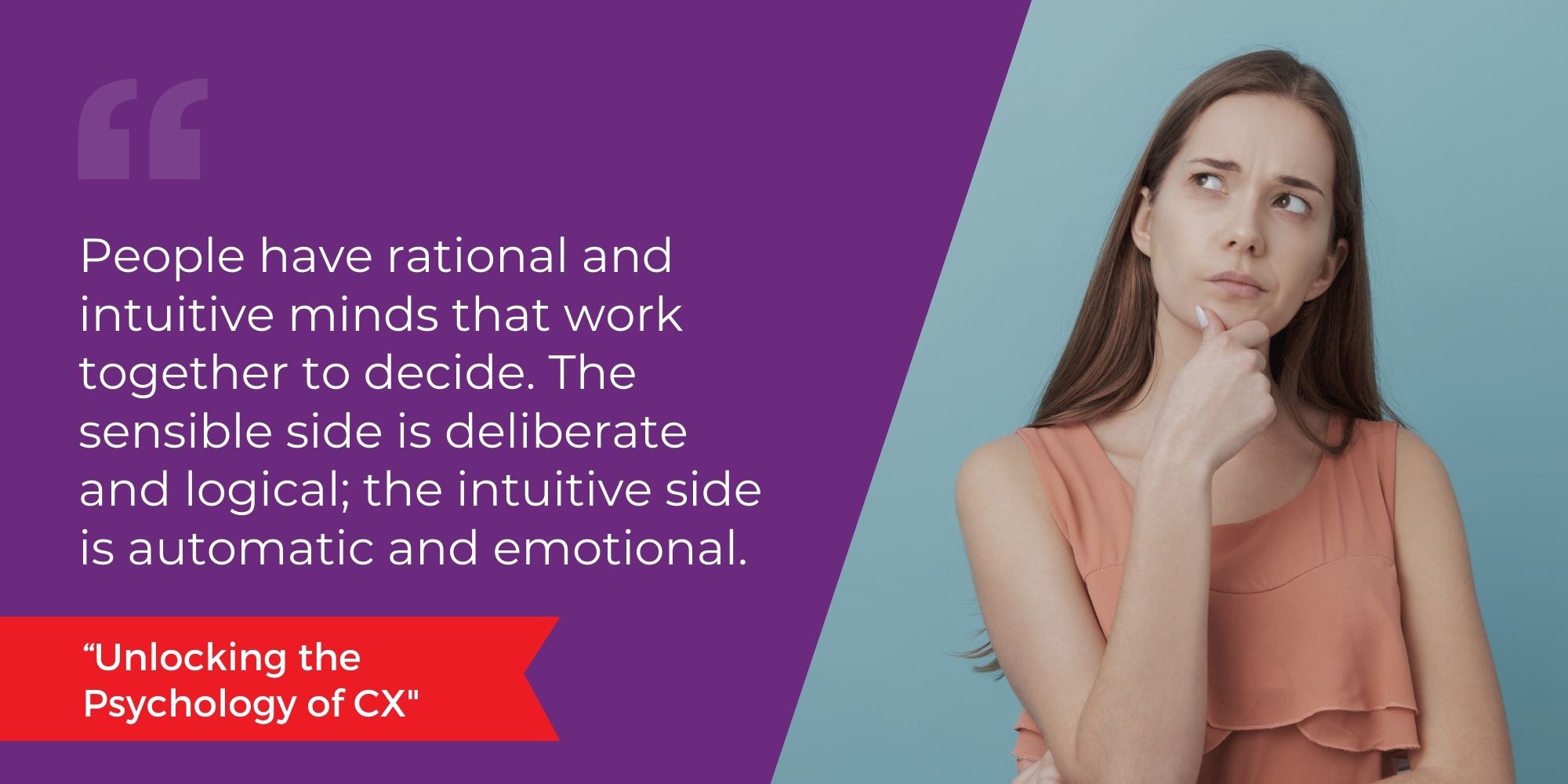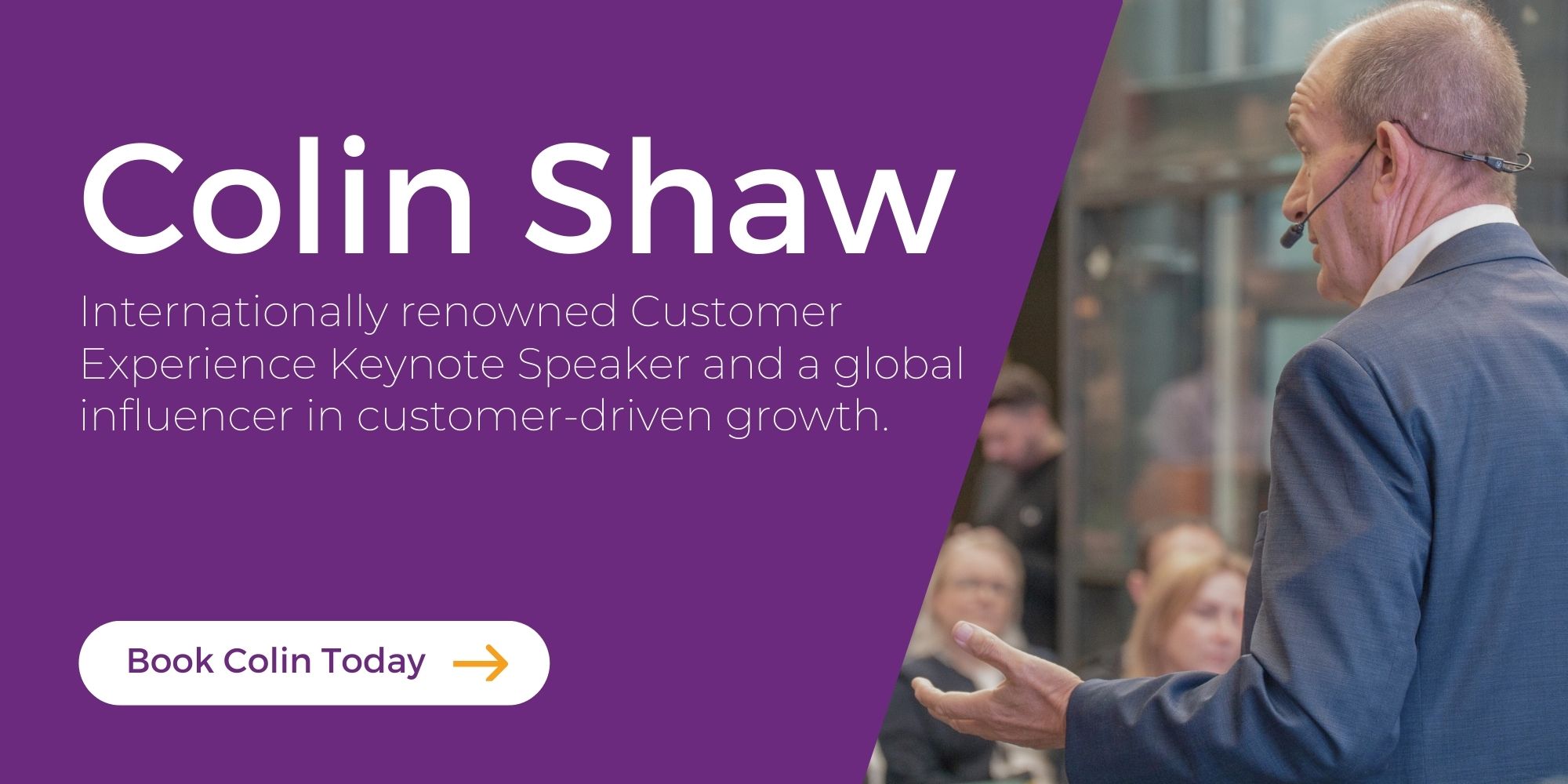Learn more about Colin Shaw: Join over 85,000 people on our LinkedIn Newsletter list or visit our website for more great podcast episodes.
Listen to the podcast:
On the podcast, we have been doing a Masterclass Series based on the principle that there is never one thing happening in a Customer Experience. Multiple things are happening, particularly from a behavioral science perspective.
In this issue of the newsletter, I wanted to share what we discussed in the final part of this podcast series, where we brought it all together. In particular, we discussed creating a mental model for your customers that helps you understand why they do what they do in your experience.
So, what is a mental model? In many ways, a mental model is like an imaginary customer’s mind, with all the peculiarities, hidden motivations, biases, and quirks we share as humans. It’s like a customer persona but with much more data and science built into it. It’s more than a generalization; a mental model is very specific.

People have been creating personas for their customers for many, many years. Years ago, a researcher conducted long-form interviews with people who worked in advertising agencies. The researcher learned that the copywriters and creatives had detailed fictional customers for whom they wrote their brand message. It was like they had created a mental model, equivalent to the concept of a child’s imaginary friend. However, instead of playing pretend with the imaginary friend, the advertising team pretended they were pitching offers to their imaginary customers.
Today, we do the same thing with customer personas. We segment customers and develop imaginary personas for each group. For example, customer group A is around a particular age, works here or there, has X kids, and lives in a single-family home. In contrast, customer group B is older and retired, with kids who no longer live at home and reside in a retirement community. Then, we craft messages that appeal to each customer persona based on those characteristics.
As we look ahead with AI entering the exercise, it’s interesting to suppose where this imaginary customer creation might go. Will AI get inside the imaginary heads of the people it creates as the target audience and then predict a response that would accurately mimic a real person in the real world? It cannot do that today, but with the rate of technological advances, imagining that we could one day is not difficult.
What Do We DO with These Mental Models?
Today, developing a mental model of our customers is like creating a persona or avatar. Then, you create scenarios or the offer you want to present to these mental models of the customer.
Suppose you want to offer a price discount. With the mental model of the customer as your audience, you would get inside the imaginary customers’ heads and imagine how they would respond to a price discount.
Some might think this approach doesn’t sound very scientific. You are right. To date, this exercise has not been run by science but by intuition. One cannot suppose correctly what a customer will do based on intuition. Intuition is not well-informed enough to produce consistent or accurate predictions about what customers will do.
I am advocating for more data input into this supposition than someone’s gut feeling about what a customer will do. Understanding customers is key to creating the mental model that will help you get the response you want from your price discount.
So, how do we do that? If we are talking about AI, it would require feeding it a lot of information so that it can create an accurate model of how humans respond to incentives.
However, memories also drive a lot of behavior. So, I would love for AI to have that input as well. But gathering that data might be more challenging than some of the other data one feeds into AI. Someone more clever than I will have to determine how to do that.
That bit about memories brings me to another important point about doing this realistically: AI will still need human input for quite a while to connect these different aspects of the customer’s mental model.
In the development of AI, I would love to see a level of understanding of customers’ mindsets—all the psychology, the hidden motivators, the memories, and everything else—that can create a scenario where AI can accurately predict how different customer types might respond.

Why Nutrition Labels Didn’t Fix the Obesity Issue
Let’s move beyond the abstract and into actual scenarios when creating mental models and presenting opportunities. We have been doing this for years but don’t always get it right. Getting into these mindsets is not easy, so it’s not surprising that it fails a lot.
Consider the rising obesity rates in the US and many other parts of the world. It’s a complicated problem with many reasons for it. However, looking at the interventions health experts have used for years, you will see that many center around providing information to individuals with obesity. The problem is information alone didn’t work.
For example, one significant move in the early 1990s in the US was requiring food to have nutrition facts on the packaging, with calorie counts, sodium and carbohydrate amounts, and other macronutrient information. Presumably, by giving people the nutrition labels, they could make informed decisions about what they ate.
However, this move was ineffective. Nutrition labels did nothing to reduce obesity rates; instead, they continued to climb as they did before the intervention. The public health experts had the wrong mental model for customers. The general public didn’t eat the way they did because they didn’t have the nutrition information; they ate that way for another reason.
My guess? It was emotional.
I have struggled with weight all my life. I still do. Many of you might recall that I have lost significant weight recently. The key to my success this time round was I understood that I was eating not because I was hungry but for emotional support. If I had a bad day, I wanted to eat something. Or if I had a good day, I wanted to eat something to celebrate. Changing that motivation is what worked for me in my latest attempt to lose weight.
However, there is an interesting side note here regarding the facts about nutrition. When I go into a restaurant now, I see the calories in the food. I am astounded at what I used to eat. Sometimes, one meal I used to eat contained the same amount of calories that I eat in a whole day today.
The point I am getting at is that once I addressed the emotional side of my eating habits, the nutrition information was useful and impactful. So, the nutrition facts were neither useless nor a waste of time. The problem with the tactic was that the labels did not address the underlying mental model of obese people, so they didn’t get the response the food experts were hoping to get.
You have to know what drives the customer behavior you want to affect. Once you understand that underlying motivation, you can use different tactics, like nutrition labels, to help drive customer behavior to the desired outcome.
Don’t Forget the Context
Another essential part of the mental model is understanding the context. Do you know the context in which your customer exists at the moment? How do they feel? What memories do they have of you or your competitors in the industry?
The context some customers experience won’t affect their decision. Other customers’ context might drive their choices entirely. That’s why you must question how your customers make decisions, even if the answers are complicated. These conditions affect financial decision-making. If you don’t understand where your customers are coming from, how do you expect to know why they do what they do?
Another easy place to start as you develop the model of your customers’ minds and determine how they make decisions is Nobel-prize-winning economist Professor Daniel Kahneman’s two-system model from his book Thinking Fast and Slow. Kahneman explains that people have rational and intuitive minds that work together to decide. The sensible side is deliberate and logical; the intuitive side is automatic and emotional.

When creating a model, ask how much the particular customer segment leans one way or the other. Are some segments more likely to be rational in a given circumstance while others are more intuitive? Why? What influences their decision-making in a given situation? Working through these scenarios with your team in a meeting can inform your model about the customers’ decision-making.
Building upon that idea, you should also consider the customer journey. Is the decision point in the journey intuitive or rational? Are the customers feeling tired at this point? How many resources do they have left to decide at this point in the day/process/customer journey?
My global Customer Experience consultancy worked with a sales organization where many sales occurred in the evenings. The team would visit people in their homes after work. At that point in the day, the customer segment would lean towards intuitive decision-making because they were tired. It was the end of the day. They had been distracted all day.
We had our client consider these bits in their experience design. What did that mean for them in terms of sales approach? How should the sales team reach customers with all that going on? Which ways are the most effective in persuading them as customers shift to other mindsets along the way?
At this level, you want to reach your customer’s mental model. Moreover, you want to achieve this level at all the various stages of the customer journey, not only at the beginning, middle, and end.
Plus, it’s not done, maybe ever. Some of your models won’t be right; the world will change; your organization will change.

So, once you do this baseline work, you don’t have a finished project, but you do have a place to start testing and determining what needs changing. This process requires scientific discipline. Testing rigorously, continuously, and ideally is key to keeping up to speed on how customers decide things.
It’s a lot of work. Not only do you have to build models about customer decision-making, but you also have to do it for each segment—and at each stage of the journey.
However, it beats the alternative, which is not knowing. If you don’t do all this work and keep at it, you will not have what you need to provide appropriate experiences for customers that drive behavior the way you require. You are doing the equivalent of giving nutrition labels to fat people who don’t care about their nutrients enough to stop eating foods that make them fat.
We try to anticipate how people will react all the time. It might be our spouse, friends and family, or co-workers. When we do this, we base it on a mental representation of the people in question. We do this automatically.
However, we advocate for a more deliberate approach regarding customers’ mental models, informed by more than our intuition. The most essential parts of consumer psychology and the behavioral sciences can tell you even more; they’re a great place to start. You are weaving all of those things together to understand your customers so that you can serve them better.
And isn’t that what we all want?

Colin has spoken at hundreds of conferences, including some of the world’s largest brands. Talk to Colin about how he can speak ‘in person’ or ‘virtually’ at your conference. Click here.


